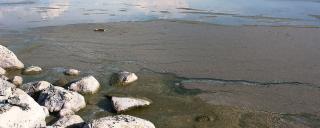
Cyanobacteria (Blue-green Algae)
Cyanobacteria, sometimes called blue-green algae, are microscopic organisms that live in all types of water and can grow quickly (bloom) in warm, slow-moving, nutrient rich waters.
Blooms generally occur in the summer and fall.
Cyanobacteria can produce toxins that can cause illness in humans. In dogs these toxins can cause illness that results in death.
Resources
The North Dakota Department of Environmental Quality maintains a list of North Dakota waters reported as currently experiencing a cyanobacteria bloom.
Blooms may also be reported on the NDDEQ website.
More Information on Cyanobacteria (Blue-Green Algae)
- Symptoms of Illnesses Caused by Freshwater Harmful Algal Blooms (U.S. Centers for Disease Control and Prevention)
- Veterinarian Reference for Cyanobacterial Blooms (U.S. Centers for Disease Control and Prevention)
